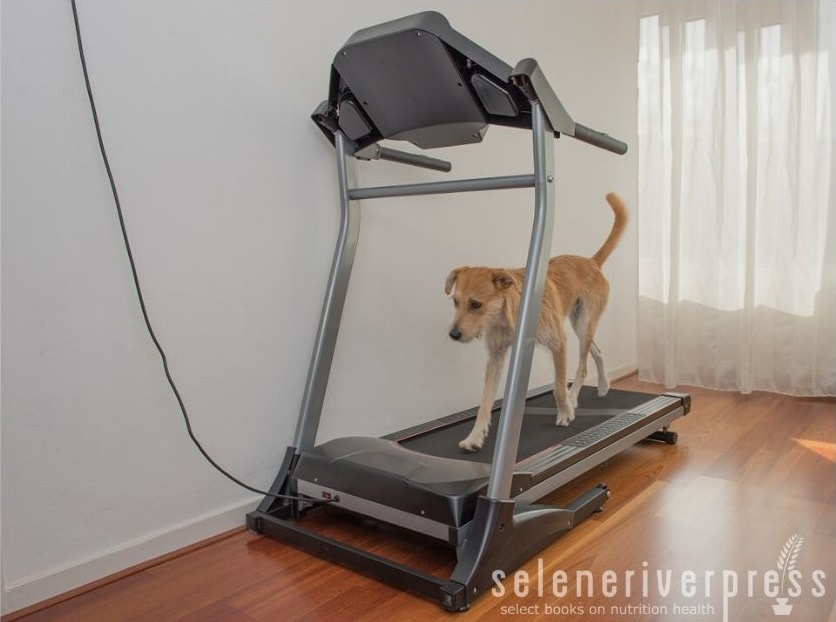Regular exercise is essential in keeping our dogs healthy and happy. It’s generally recommended that dogs get anywhere from thirty minutes to two hours of activity every day. Weekend walks are great, but they’re not enough. Larger breeds such as retrievers, Dobermans, and shepherds need more daily physical activity, while smaller dogs and toy breeds (terriers and poodles) don’t require as much exercise. Bulldogs, boxers, pugs, and other short-nosed, flat-faced breeds (also known as brachycephalic breeds), cannot tolerate a lot of daily exercise. The shortened noses or faces of brachycephalic breeds might not be able to breathe in air as effectively as their long-nosed friends, so be extra careful with them.
In most situations, a casual walk around the house or an indoor facility will be sufficient. Just like humans, it’s important to tone the muscles, encourage the body and metabolism to function well, and stimulate the brain. Workouts not only help keep your dog fit, but they can also promote well-mannered behavior and increase socialization. Most dogs will become couch potatoes if they’re not encouraged to move around.
Dogs that don’t get enough physical activity may gain weight and become stiff, appear bored or frustrated, or release their energy in undesirable ways—destructive behavior, increased barking and whining, and/or becoming hyperactive or difficult to control.
Given all that, you can see why exercise is so vital. However, when the weather is less than ideal, getting out there with our dogs becomes more difficult. Consider indoor exercise as an alternative. Though you may have to get a little creative, it can also be fun and beneficial.
Before you choose the activity and the best location in the house, consider the size, age, and safety of your pet. If your dog has any health conditions, talk with your veterinarian about any limitations you should keep in mind. I also recommend setting up an annual Heart Sound Recorder evaluation to check on the rate, rhythm and tone of your dog’s heart (the organ most responsive to nutrition). Indeed, nutritional deficiencies in the heart may indicate other deficiencies in the body that can develop into illness and disease.
Here are just a few of my favorite indoor activities with my dogs:
Run your dog up and down the stairs. I like to start at the top and toss a ball or toy down the stairs. Once they grab the toy, call their name and get them to bring the toy to you. If you could use some exercise yourself, you can benefit from this as well by racing up and down the stairs with your dog.
Play keep away. This activity requires a partner. Toss the ball or toy back and forth, encouraging your dog to get it. It’s great exercise and fun for you and your partner.
Get your dog on the treadmill. Training a dog to use a treadmill takes some patience, but with time and effort they should learn to use the machine with ease. First, allow your dog to get comfortable with the sight and sound of a running treadmill (some dogs don’t like motorized machines). Next, place them on the treadmill and give them a treat. Turn the treadmill on the lowest speed. You may use the dog’s leash to help keep him on the treadmill—but never tie your dog to the treadmill. Once your dog is adjusted, you can gradually increase the speed to provide a more challenging workout.
Go for an indoor swim. Dogs of all sizes and breeds love to swim. Sure, it’s fun, but it’s also great exercise. Just five minutes of swimming is the equivalent of twenty minutes of walking. Small dogs can even benefit from swimming in the bathtub at home. Larger and more active dogs love going to indoor dog swimming pools, many of which are open year-round. Look online for one near you!
Play hide and seek. Unless your dog is well trained, you may need a partner for this game as well. Tell your dog to sit, and then go hide. Call your dog and let them find you. Of course, the goal here isn’t winning but just to have fun and get some exercise.
If your dog likes long walks and getting outside the house, consider walking around pet-friendly public locations such as Petco, Home Depot, Lowes, and Bass Pro Shops.
Cold weather doesn’t necessarily mean your dog must be bored and pent up with no exercise. With these fun winter-weather boredom busters, you might even start looking forward to those snowy, rainy, or sweltering days!
Images from iStock/sandorgora (main), monkeybusinessimages (post).


